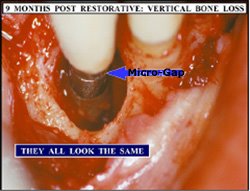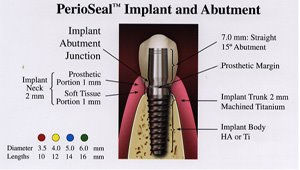Superior Esthetics without Micro-leakage of Bacteria and Bone Loss

In the May/June 2006 issue of Implant News & Views, Dr. Donald Callan explains that one of the most perplexing problems of implant placement has been achieving optimal esthetics and that making implants appear as close as possible to natural teeth should be a high priority to accomplish this. Often micro-gaps are created at the implant-abutment junction (IAJ), which resides in close proximity to or just below the bony crest. The presence of the IAJ micro-gap in close approximation to bone is considered to play a major role in peri-implant inflammation and subsequent circumferential bone loss. Leakage of fluids and penetration of the micro-gaps by periodontopathic bacteria leads to the formation of biofilms that are resistant to hygienic efforts or host defense mechanisms.
The PerioSeal?implant [888-446-7126] is designed as a conventional standard dental crown, utilizing a ferrule attachment and dental cement to simplify t
 he restorative phase. This greater surface area contact and better distribution of occlusal force creates a strong connection without a micro-gap to harbor periodontal pathogens. By capturing and sealing the IAJ within the crown, PerioSeal?implants eliminate a potential haven for organisms adjacent to healthy soft tissue. Dr. Callan shows 5 clinical cases to demonstrate this concept. The article is referenced
he restorative phase. This greater surface area contact and better distribution of occlusal force creates a strong connection without a micro-gap to harbor periodontal pathogens. By capturing and sealing the IAJ within the crown, PerioSeal?implants eliminate a potential haven for organisms adjacent to healthy soft tissue. Dr. Callan shows 5 clinical cases to demonstrate this concept. The article is referenced


